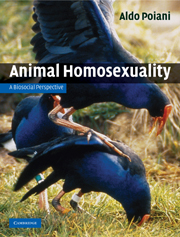Book contents
- Frontmatter
- Dedication
- Contents
- Contributors
- Acknowledgements
- Preface
- 1 Animal homosexuality in evolutionary perspective
- 2 The comparative study of homosexual behaviour
- 3 Genetics of homosexuality
- 4 Ontogenetic processes
- 5 The endocrine and nervous systems: a network of causality for homosexual behaviour
- 6 Immunology and homosexuality
- 7 Sexual segregation effects
- 8 The social, life history and ecological theatres of animal homosexual behaviour
- 9 Homosexual behaviour in primates
- 10 A Biosocial Model for the evolution and maintenance of homosexual behaviour in birds and mammals
- Appendix 1 Glossary
- Appendix 2 Predictions of the Synthetic Reproductive Skew Model of Homosexuality and results obtained in the comparative tests of the model carried out in birds and mammals
- Appendix 3 Comments on further results of comparative analyses of independent contrasts reported in the full correlation matrices of birds and mammals
- References
- Index
- Plates
- References
References
Published online by Cambridge University Press: 05 July 2014
- Frontmatter
- Dedication
- Contents
- Contributors
- Acknowledgements
- Preface
- 1 Animal homosexuality in evolutionary perspective
- 2 The comparative study of homosexual behaviour
- 3 Genetics of homosexuality
- 4 Ontogenetic processes
- 5 The endocrine and nervous systems: a network of causality for homosexual behaviour
- 6 Immunology and homosexuality
- 7 Sexual segregation effects
- 8 The social, life history and ecological theatres of animal homosexual behaviour
- 9 Homosexual behaviour in primates
- 10 A Biosocial Model for the evolution and maintenance of homosexual behaviour in birds and mammals
- Appendix 1 Glossary
- Appendix 2 Predictions of the Synthetic Reproductive Skew Model of Homosexuality and results obtained in the comparative tests of the model carried out in birds and mammals
- Appendix 3 Comments on further results of comparative analyses of independent contrasts reported in the full correlation matrices of birds and mammals
- References
- Index
- Plates
- References
- Type
- Chapter
- Information
- Animal HomosexualityA Biosocial Perspective, pp. 443 - 534Publisher: Cambridge University PressPrint publication year: 2010



